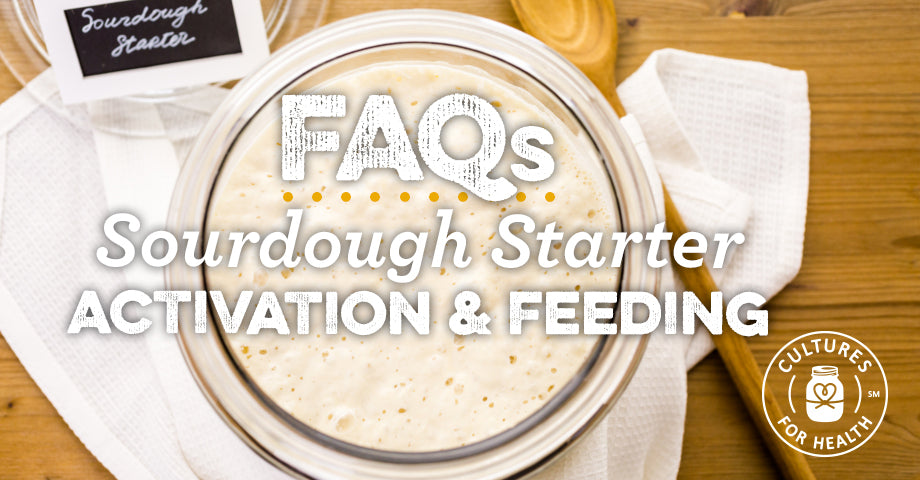
Still considering using a sourdough starter? Learn more with Sourdough Starter FAQ.
Q. Where should I keep my sourdough culture?
A. Sourdough starter that is used frequently can be maintained at room temperature, 70-85ºF is best. Starter that is used less frequently can be stored in the refrigerator with a tight-fitting lid. Instructions on maintaining sourdough starter at both room temperature and in the refrigerator are included with your starter and can be found here.
Q. Can I use freshly ground flour to feed my sourdough starter? To bake sourdough bread?
A. Maybe. Some people find that using freshly ground flour is problematic. If that is the case, we recommend aging the flour by placing it in a bowl on the counter, covered lightly with a dish towel, for one or more weeks before using it to feed your sourdough culture. Once it is time to bake bread, use freshly ground flour as the flour ingredient in the bread recipe.
Q. What type of water should I use when feeding my sourdough starter?
A. While we recommend using water that is as free of contaminants as possible, sourdough is fairly resilient and can generally handle tap water provided it is of a quality which you consider safe to drink. Learn more about choosing water for culturing.
Q. What is "fresh sourdough starter" that is called for in most recipes?
A. Fresh sourdough starter is a term often used in recipes to refer to recently fed, active sourdough starter. Learn how to prepare fresh starter for baking.
Q. How do I switch a sourdough culture from using white flour to whole wheat flour, rye flour, etc.?
A. Switching a sourdough starter to a new type of flour is a simple process. Always retain a portion of the original starter, just in case.
Q. How do I take a break from feeding my sourdough starter?
A. There are several ways to preserve your sourdough culture if you are unable to maintain it for a period of time, from refrigeration to dehydration. Choose the method that works best for you in our article on Taking a Break from a Sourdough Starter.
Q. I activated my packet of sourdough starter two days ago and have been feeding it regularly. How long before it gets bubbly?
A. A packet of sourdough starter may take a few days to become bubbly. Generally speaking, cooler temperatures will slow the process down and warmer temperatures will speed the process up. Please be patient during this process. To learn more, view our video on Activating a Sourdough Starter.
Q. I just started activating the packet of sourdough starter. How many times will I need to feed it before I can put it in the refrigerator?
A. It is important to continue feeding the starter at room temperature until it is reliably bubbly a few hours after feeding, for 3 consecutive feedings. Getting to that point can take 3 to 7 days of feeding the starter every 12 to 24 hours (every 2 to 4 hours for our Gluten-free Sourdough Starter).
Q. How often should I feed my sourdough starter?
A. Refrigerated sourdough starter requires weekly feedings. When maintained at room temperature, the sourdough starter should be fed every 12 to 24 hours, depending on the specific starter and culturing conditions.
Our Gluten-free Sourdough Starter requires more frequent feedings: every 3-4 days when stored in the refrigerator or every 4 hours when maintained at room temperature.
Q. My sourdough starter has been in the refrigerator. How many times should I feed it before baking with it?
A. We recommend a minimum of three feedings, prior to baking with the starter, to ensure the starter is fully active.
Q. I’ve been feeding my starter, but now I have a gallon of sourdough starter. What can I do with it? How do I feed my starter without making too much?
A. When feeding without baking frequently, it may be useful to discard part of the starter before each feeding, until it is time to bake. Discarded starter may be literally discarded or used for other recipes that do not require so much lift. To learn more, consult our article on Using Discarded Sourdough Starter.
Q. How can I make my sourdough starter more or less sour?
A. It is fairly simple to adjust the sourness of any sourdough starter, to make it more mild or more sour, depending on taste preference. Check out the tips in our article Making Truly Sour Sourdough Bread.
Q. I have my whole wheat sourdough starter active and bubbly and ready to bake. Do I have to use whole wheat flour in my recipe, too?
A. The starter is simply the leavening in your recipe. As long as you feed your starter with the appropriate flour, you may use any flour or combination of flours as the ingredient in your recipe.
Q. Are there any tips for getting sourdough bread to rise well?
A. There are generally three factors that contribute to a good sourdough proofing session: active yeast, adequate kneading, and time. For more tips and information on baking sourdough bread, watch our how-to video, How to Make Sourdough Bread.
Q. Can I use a bread machine to make sourdough bread?
A. Most bread machines have too short a rise cycle. The machines are meant to accommodate commercial yeast, which rises much faster than sourdough. If your machine allows you to adjust the rise cycle timing, it can work. Learn more in our article Using a Bread Machine to Make Sourdough.














